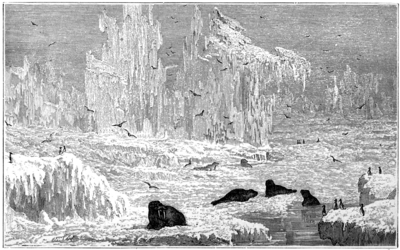
 here is a tendency on the part of most writers on the subject of Polar Regions—especially compilers—to dwell disproportionately on the gloomy side of the picture; insomuch that readers are led, not to over-estimate the grand and the terrible aspects of the polar oceans, but to under-estimate the sweet and the beautiful influences that at certain periods reign there.
here is a tendency on the part of most writers on the subject of Polar Regions—especially compilers—to dwell disproportionately on the gloomy side of the picture; insomuch that readers are led, not to over-estimate the grand and the terrible aspects of the polar oceans, but to under-estimate the sweet and the beautiful influences that at certain periods reign there.
We quarrel not with authors for dwelling on the tremendous and the awful. Too much cannot be said on these points; but while they do not by any means paint the dark side of their picture too black, they fail to touch in the lights with sufficient brilliancy. We have had some personal experience of the arctic regions, and have found it extremely difficult to get many persons—even educated men and women—to understand that there is a summer there, though a short one; that in many places it is an uncommonly hot and excessively brilliant summer; and that the sun, as if to make amends for its prolonged absence in winter, shines all night as well as all day, blazing on the crystal icebergs and pure snow (which never disappear from those seas) with a degree of splendour that renders the far north transcendently beautiful and pre-eminently attractive.
We admit freely that the prevailing character of arctic seas, during the greater part of the year, is dark, gloomy, forbidding. But this is the very reason why their brief but cheering smiles should be brought prominently into the foreground, and, if they cannot in justice be dwelt on long, at least be touched upon with emphasis.
Why, in some of our cyclopædia accounts of the realms of "thick-ribbed ice," so much prominence is given to "the horrors and wide desolation of the scene," and so much graphic power is expended in working up the reader's imagination to a conception of the dreadful dangers and the appalling terrors that await the madman who should dare to venture within the arctic circle, that persons who have not been there might well be tempted to shrink in affright from the very contemplation of a region in which there does not appear to be one redeeming quality.
We repeat, that we do not think the one side of the picture has been too darkly painted,—but the other side has been painted too slightly.
At the same time, we would caution our readers against jumping to the opposite extreme. The dark side of the picture is in reality out of all proportion to the light. And we do not hesitate to state our confirmed opinion, that the arctic regions are more interesting to read about than pleasant to dwell in.
Having, then, defended the lights, let us commence our investigations with the shadows.
Those oceans lying within the arctic circle exhibit phenomena so grand, so wonderful, and so varied, that they claim distinct and separate treatment from the ocean as a whole. Here the extreme cold acts with such power, and produces such extraordinary results, that it is difficult to find words or similes by which to convey a just conception of nature's aspects to the general reader.
During nearly two-thirds of the year the arctic regions are under the absolute dominion of winter; and for many weeks of that bitter season they are shrouded with the mantle of a dark, sunless night. The entire ocean is locked in the embrace of a covering of ice many feet thick, so that its liquid aspect is thoroughly removed; and, owing to ice-masses scattered over its surface, together with mounds of drifted snow, it bears a much stronger resemblance to the land than to the sea. Gales of wind sometimes sweep over those frozen plains in bitter fury, hurling the snow into the air in vast eddying masses, and threatening destruction to any living creature that may chance to be exposed to them—not so much from their violence, however, 
AN ARCTIC SCENE.
It might be supposed that in such a climate animal life could scarcely exist; but such is not the case. The inhabitants of part of the arctic regions, named Esquimaux (more correctly Eskimos, with the accent on the last syllable), are a stout, hardy, healthy race; and the polar bears, foxes, wolves, seals, musk-oxen, walruses, &c., that dwell there, seem to enjoy their existence just as much as do the animals of more favoured and warmer climes.
During the short but hot summer of the arctic regions, the immense masses of ice formed in winter are by no means cleared away. A great part of the heat of early summer (there is no season there that merits the name of spring) is spent in breaking up the solid crust of ice on the sea, a large proportion of which is carried south by the currents that flow to the equator, and melted long before they reach the temperate zones. But a considerable quantity of broken ice-masses get locked in narrow places or stranded on shallows; and although they undergo the process of melting the whole summer, they are not much diminished ere the returning frost stops the process and locks them in the new ice of a succeeding winter.
Thus there is no period of the year in which large quantities of ice may not be seen floating about in the arctic seas.
This fact it is that enables us to speak appropriately of the scenery of the Arctic Ocean. And assuredly this scenery of the ice is exceedingly and

THE POLAR SEA.
strikingly beautiful. The imagination cannot conceive the dazzling effect of a bright summer day in those regions, when the ocean is clear as glass, and ice-lumps and ice-mountains of every shape and size are glittering in the sun's rays with intense brilliancy, while the delicate whiteness of these floating islands, and the magical atmospheric illusions by which they are frequently surrounded, render the scene pre-eminently fairy-like.
All the navigators who have penetrated into the arctic seas speak with enthusiasm of the splendour of floating ice-masses. They take the most curious and fantastic shapes; sometimes appearing like great cities of white marble, with domes and towers and spires in profusion; sometimes looming huge and grand like fortresses, and many of them with their summits overhanging so much as to suggest the idea that they are about to fall. This, indeed, they often do, adding to the grandeur of the scene, and not a little to the danger, should ships chance to be in the neighbourhood.
The atmospheric illusions, before mentioned, are the result of different temperatures existing within a few miles of each other, and which are caused by the presence of large bodies of ice. The effect of this is to cause the ice-masses on the horizon to appear as if floating in the air, and to distort them into all sorts of shapes, even turning them upside down, and thus affording to an imaginative mind a most ample and attractive field wherein to expatiate.
To ascertain the causes of facts and effects so curious must prove interesting to all who have inquiring minds. We will, therefore, attempt to describe and account for arctic phenomena in the following chapters as simply as may be.
![]()
This work was published before January 1, 1929, and is in the public domain worldwide because the author died at least 100 years ago.
Public domainPublic domainfalsefalse